Abstract
Methylpentynol, paraldehyde, amylobarbitone and procainamide blocked transmission through the cat superior cervical ganglion, and antagonized the ganglion-stimulating actions of acetylcholine and carbachol injected intra-arterially to the ganglion. Comparison with the effects of tetraethylammonium indicated that the impaired response to acetylcholine could not wholly account for the failure of transmission, which suggested that an impaired release of transmitter substance was a contributory factor. Methylpentynol, paraldehyde and procainamide also blocked the ganglion-stimulating action of potassium chloride. In contrast, amylobarbitone and pentobarbitone did not block the stimulating action of potassium chloride, but antagonized specifically the actions of acetylcholine and carbachol. The anti-acetylcholine activities of the two barbiturate drugs at this site accord with their relative ganglion-blocking activities. It is concluded that the ganglion-blocking action of methylpentynol, paraldehyde and procainamide arises from a nonspecific depression of both presynaptic and postsynaptic elements in the ganglion, but that barbiturate compounds act more specifically on the acetylcholine receptor.
Full text
PDF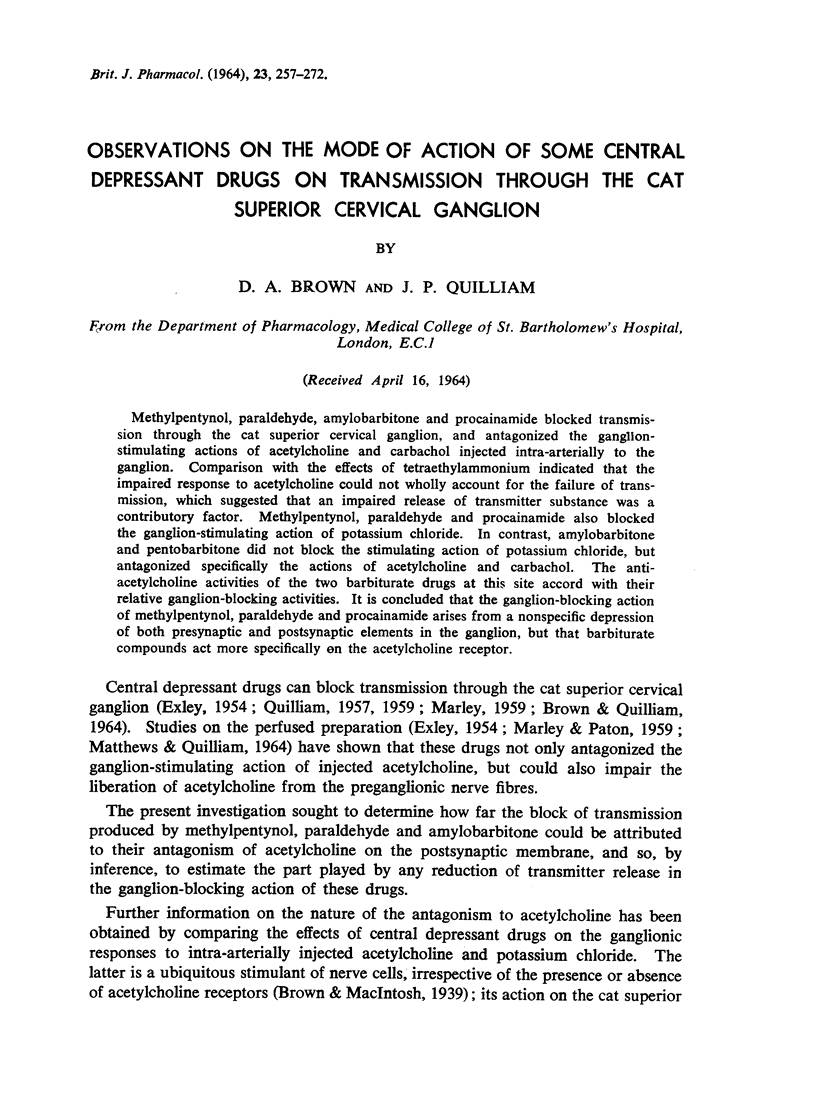
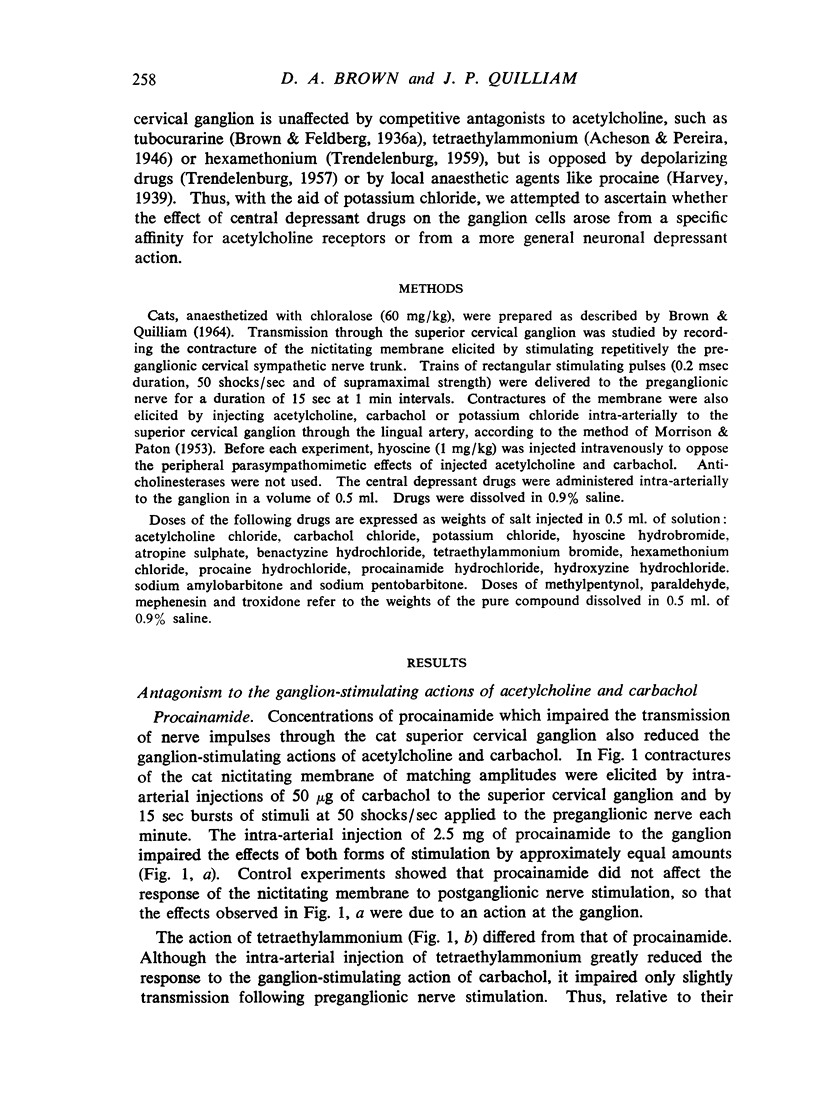
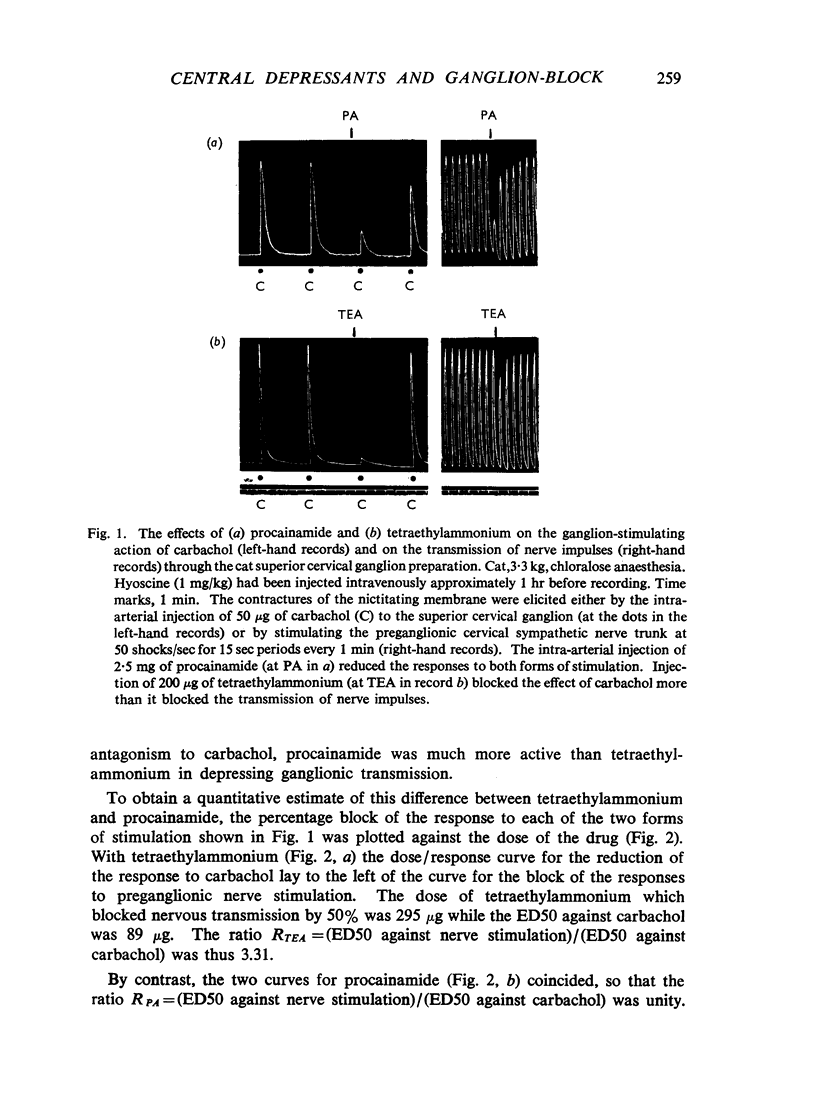

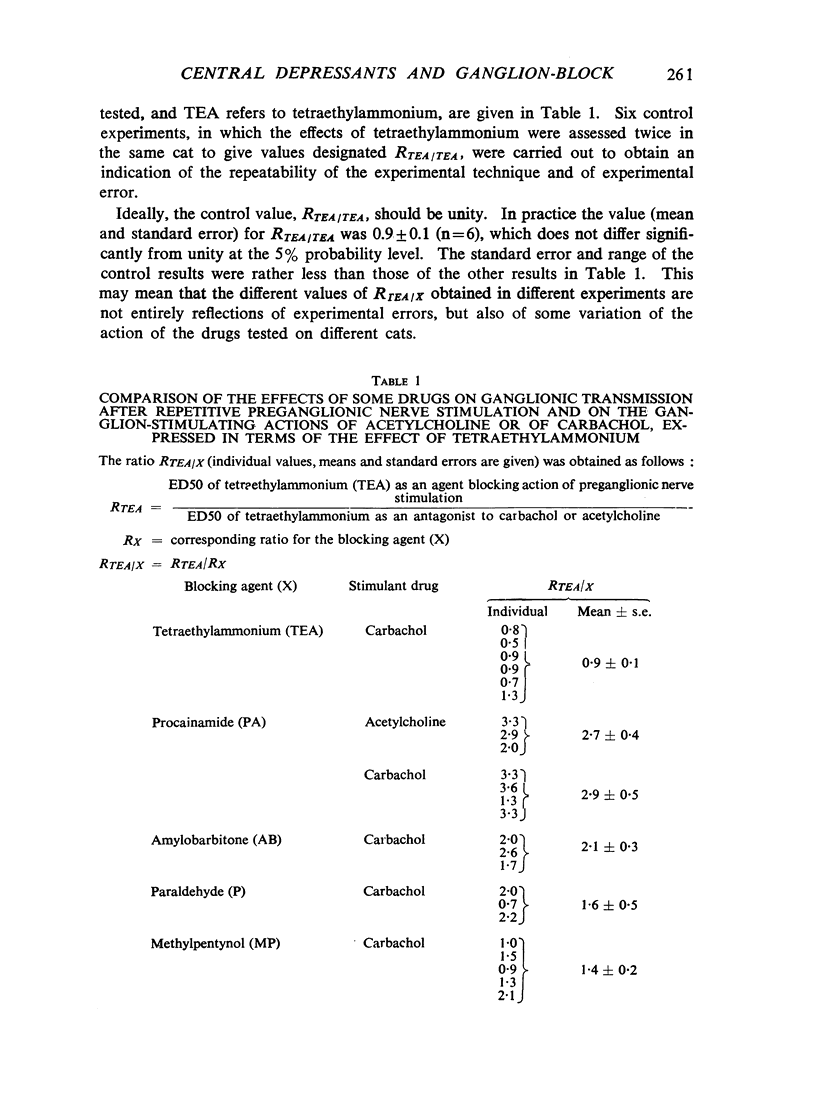
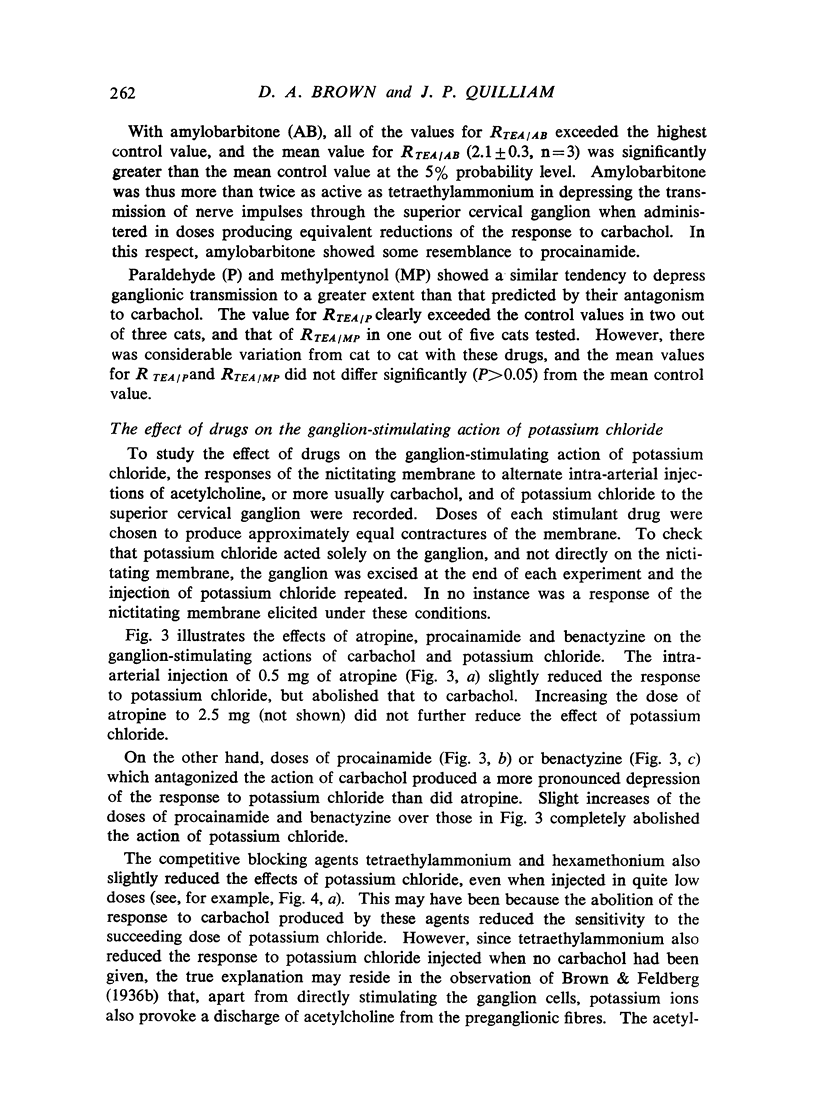
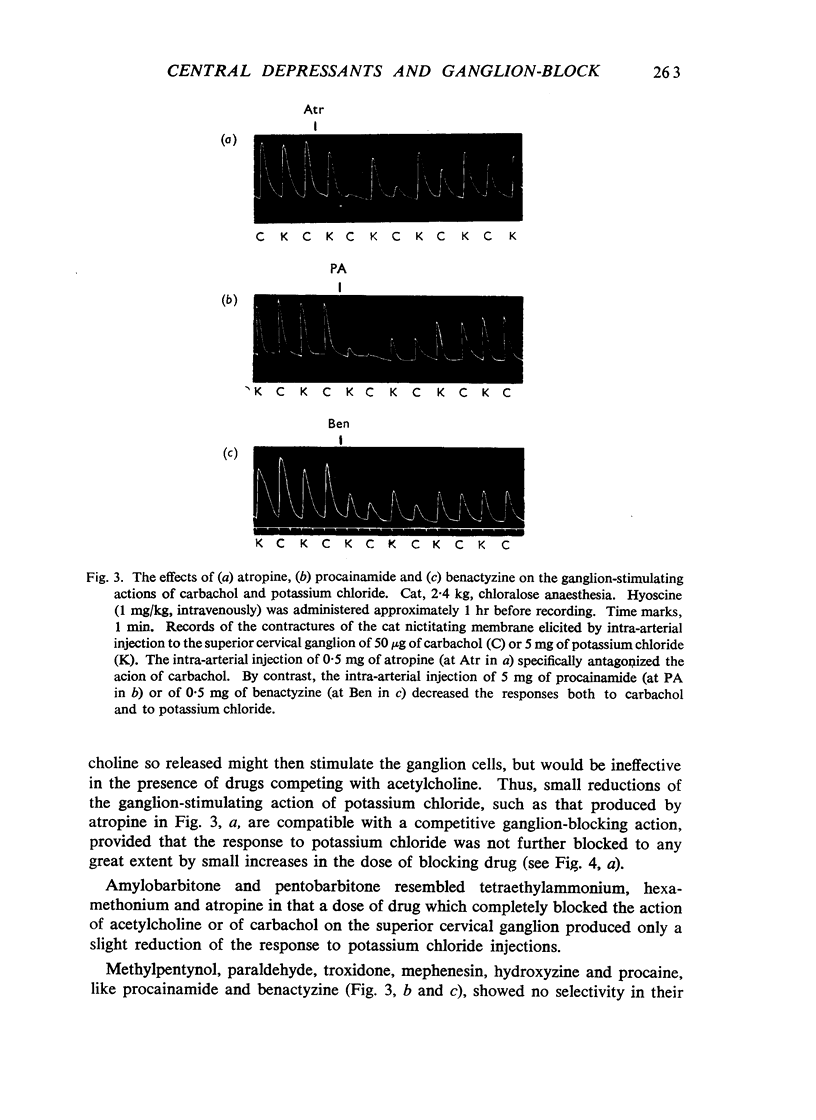
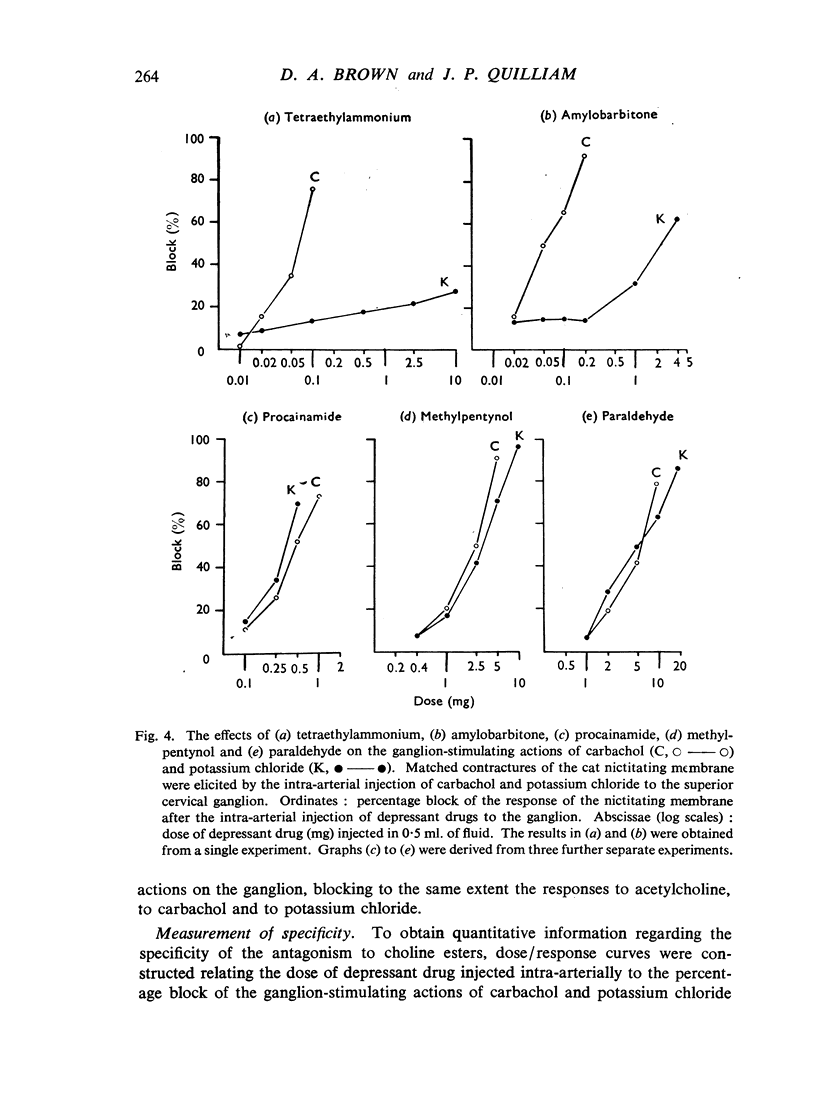
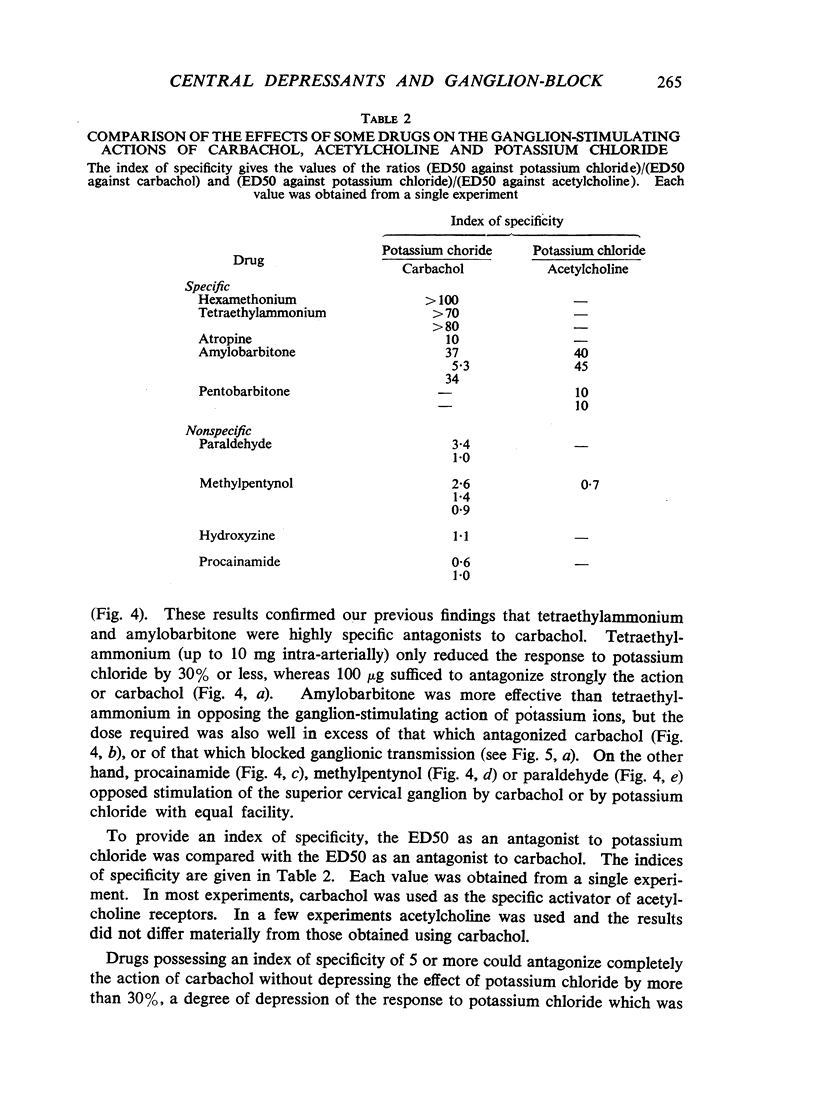
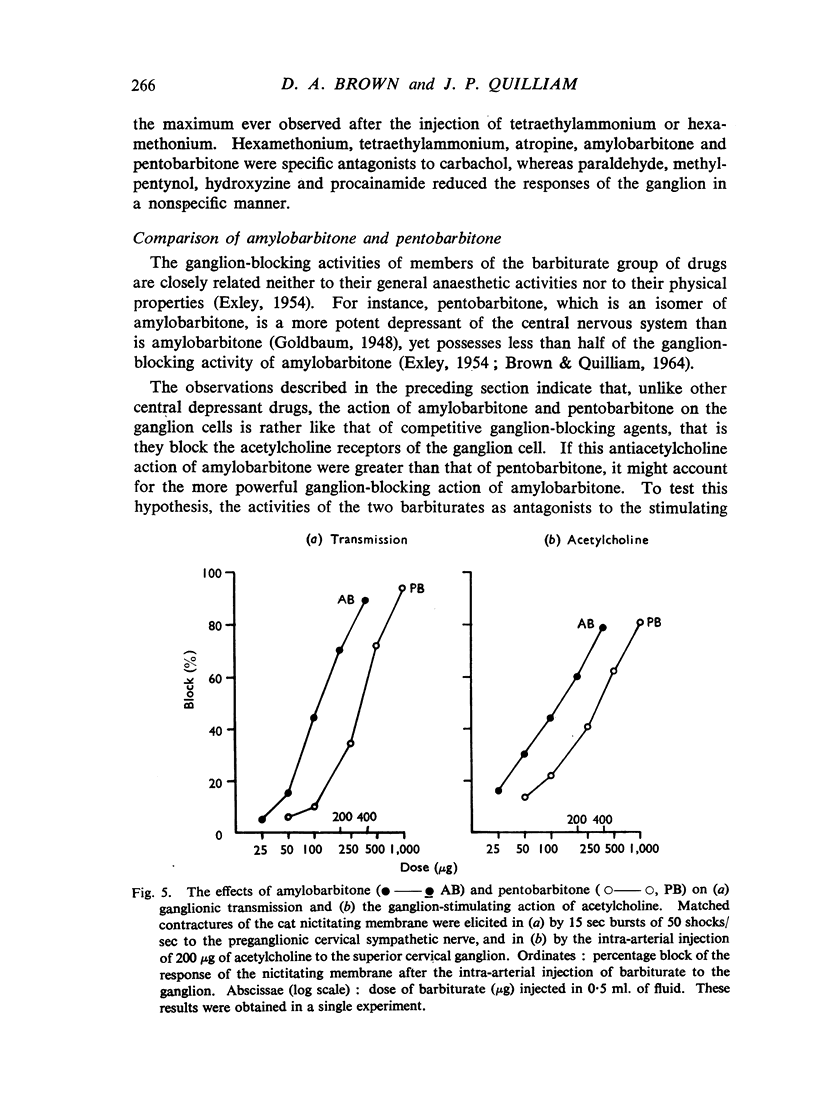
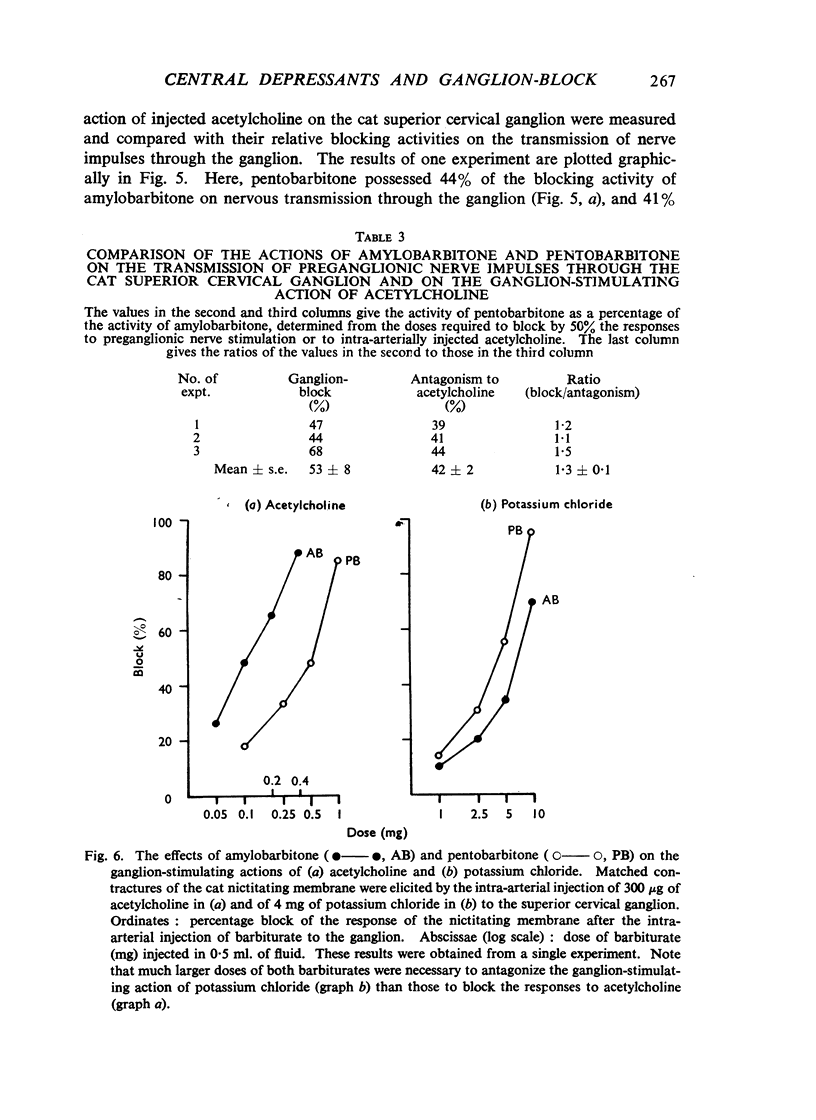
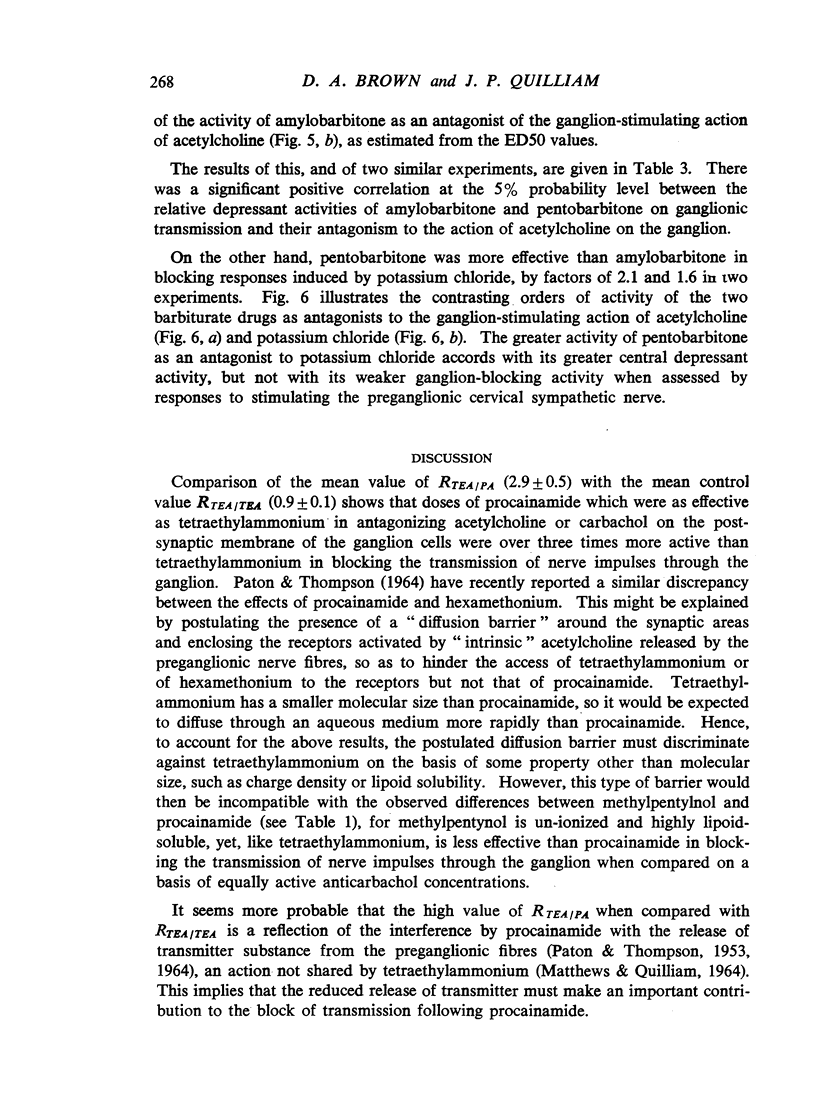
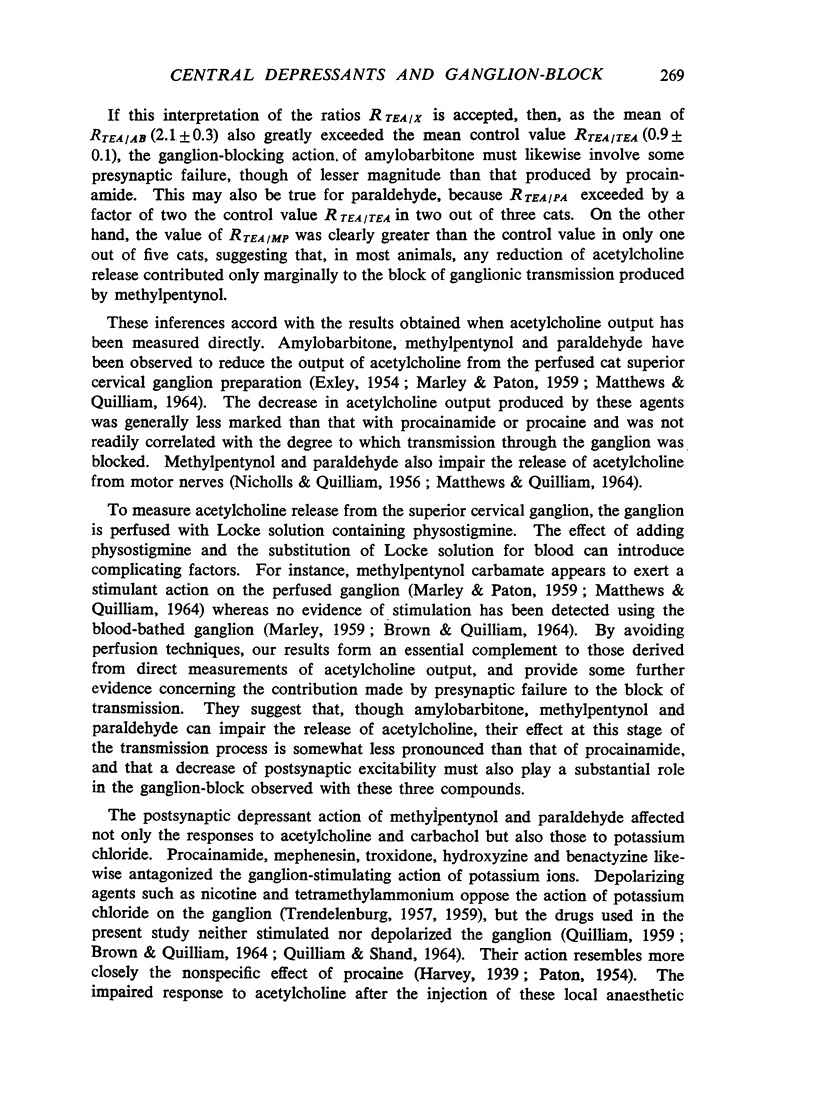
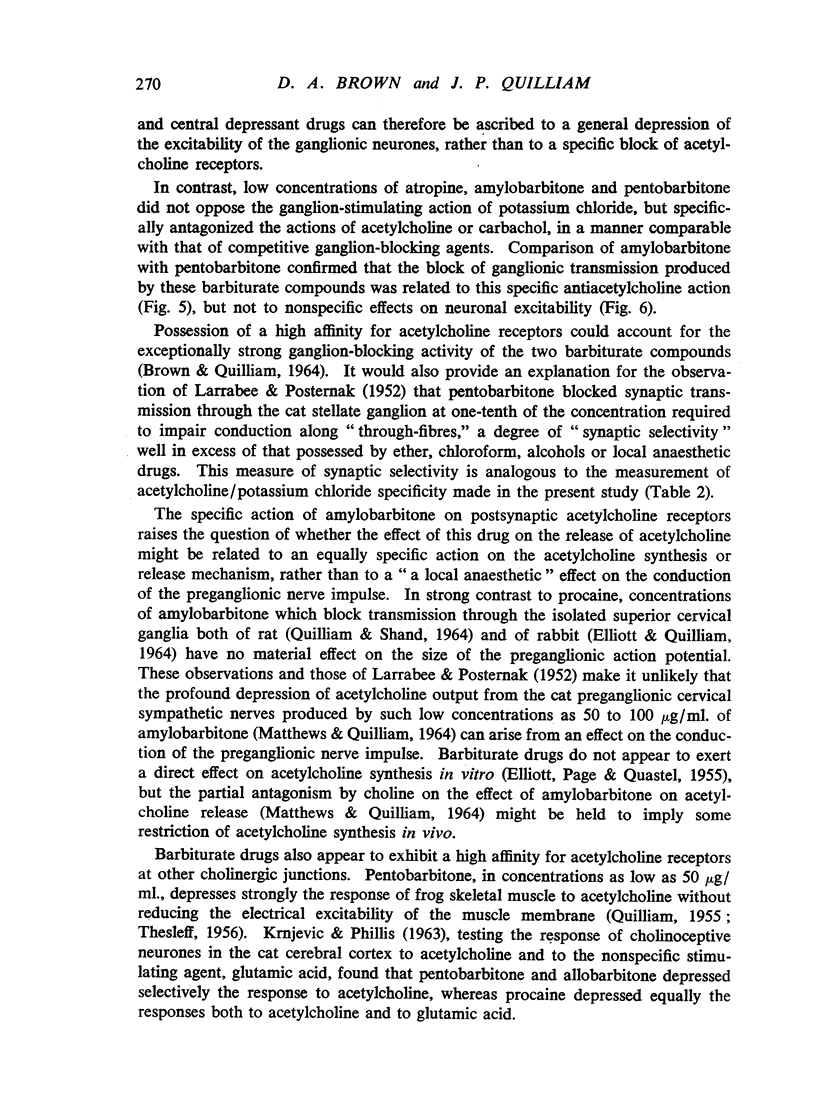
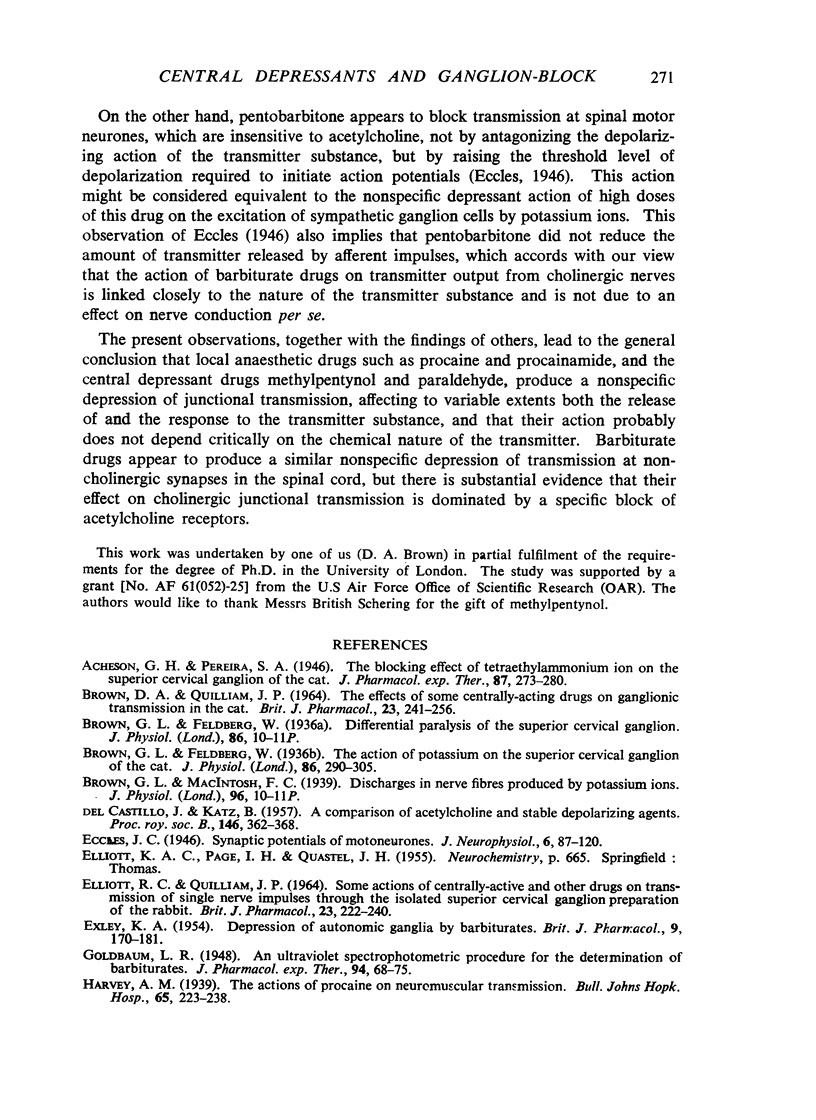
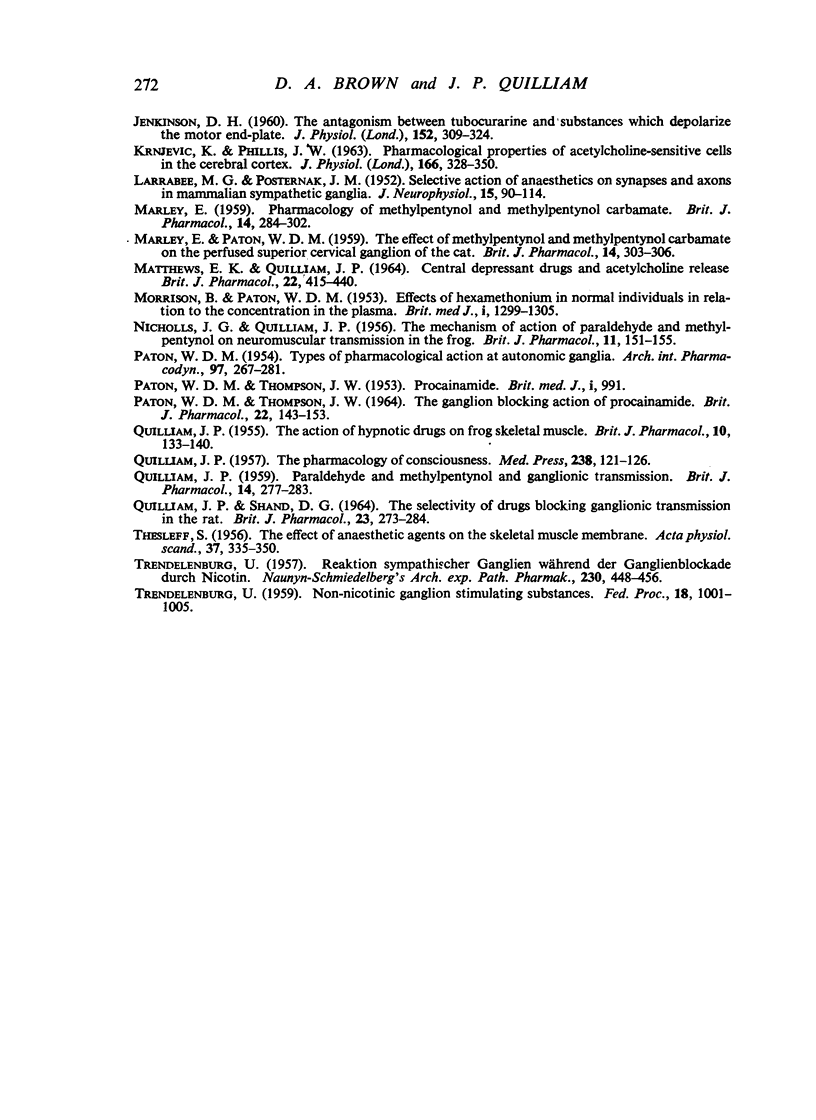
Selected References
These references are in PubMed. This may not be the complete list of references from this article.
- Brown G. L., Feldberg W. The action of potassium on the superior cervical ganglion of the cat. J Physiol. 1936 Mar 9;86(3):290–305. doi: 10.1113/jphysiol.1936.sp003364. [DOI] [PMC free article] [PubMed] [Google Scholar]
- DEL CASTILLO J., KATZ B. A comparison of acetylcholine and stable depolarizing agents. Proc R Soc Lond B Biol Sci. 1957 May 7;146(924):362–368. doi: 10.1098/rspb.1957.0017. [DOI] [PubMed] [Google Scholar]
- ELLIOTT R. C., QUILLIAM J. P. SOME ACTIONS OF CENTRALLY ACTIVE AND OTHER DRUGS ON THE TRANSMISSION OF SINGLE NERVE IMPULSES THROUGH THE ISOLATED SUPERIOR CERVICAL GANGLION PREPARATION OF THE RABBIT. Br J Pharmacol Chemother. 1964 Oct;23:222–240. doi: 10.1111/j.1476-5381.1964.tb01582.x. [DOI] [PMC free article] [PubMed] [Google Scholar]
- EXLEY K. A. Depression of autonomic ganglia by barbiturates. Br J Pharmacol Chemother. 1954 Jun;9(2):170–181. doi: 10.1111/j.1476-5381.1954.tb00837.x. [DOI] [PMC free article] [PubMed] [Google Scholar]
- JENKINSON D. H. The antagonism between tubocurarine and substances which depolarize the motor end-plate. J Physiol. 1960 Jul;152:309–324. doi: 10.1113/jphysiol.1960.sp006489. [DOI] [PMC free article] [PubMed] [Google Scholar]
- Krnjević K., Phillis J. W. Pharmacological properties of acetylcholine-sensitive cells in the cerebral cortex. J Physiol. 1963 May;166(2):328–350. doi: 10.1113/jphysiol.1963.sp007107. [DOI] [PMC free article] [PubMed] [Google Scholar]
- LARRABEE M. G., POSTERNAK J. M. Selective action of anesthetics on synapses and axons in mammalian sympathetic ganglia. J Neurophysiol. 1952 Mar;15(2):91–114. doi: 10.1152/jn.1952.15.2.91. [DOI] [PubMed] [Google Scholar]
- MARLEY E., PATON W. D. The effect of methylpentynol and methylpentynol carbamate on the perfused superior cervical ganglion of the cat. Br J Pharmacol Chemother. 1959 Jun;14(2):303–306. doi: 10.1111/j.1476-5381.1959.tb01401.x. [DOI] [PMC free article] [PubMed] [Google Scholar]
- MARLEY E. Pharmacology of methylpentynol and methylpentynol carbamate. Br J Pharmacol Chemother. 1959 Jun;14(2):284–302. doi: 10.1111/j.1476-5381.1959.tb01400.x. [DOI] [PMC free article] [PubMed] [Google Scholar]
- MATTHEWS E. K., QUILLIAM J. P. EFFECTS OF CENTRAL DEPRESSANT DRUGS UPON ACETYLCHOLINE RELEASE. Br J Pharmacol Chemother. 1964 Apr;22:415–440. doi: 10.1111/j.1476-5381.1964.tb02047.x. [DOI] [PMC free article] [PubMed] [Google Scholar]
- MORRISON B., PATON W. D. M. Effects of hexamethonium on normal individuals in relation to its concentration in the plasma. Br Med J. 1953 Jun 13;1(4823):1299–1305. doi: 10.1136/bmj.1.4823.1299. [DOI] [PMC free article] [PubMed] [Google Scholar]
- NICHOLLS J. G., QUILLIAM J. P. The mechanism of action of paraldehyde and methylpentynol on neuromuscular transmission in the frog. Br J Pharmacol Chemother. 1956 Jun;11(2):151–155. doi: 10.1111/j.1476-5381.1956.tb01045.x. [DOI] [PMC free article] [PubMed] [Google Scholar]
- PATON W. D., THOMPSON J. W. THE GANGLION BLOCKING ACTION OF PROCAINAMIDE. Br J Pharmacol Chemother. 1964 Feb;22:143–153. doi: 10.1111/j.1476-5381.1964.tb01552.x. [DOI] [PMC free article] [PubMed] [Google Scholar]
- PATON W. D. Types of pharmacological action at autonomic ganglia. Arch Int Pharmacodyn Ther. 1954 Apr 1;97(3-4):267–281. [PubMed] [Google Scholar]
- QUILLIAM J. P. Paraldehyde and methylpentynol and ganglionic transmission. Br J Pharmacol Chemother. 1959 Jun;14(2):277–283. doi: 10.1111/j.1476-5381.1959.tb01399.x. [DOI] [PMC free article] [PubMed] [Google Scholar]
- QUILLIAM J. P., SHAND D. G. THE SELECTIVITY OF DRUGS BLOCKING GANGLIONIC TRANSMISSION IN THE RAT. Br J Pharmacol Chemother. 1964 Oct;23:273–284. doi: 10.1111/j.1476-5381.1964.tb01585.x. [DOI] [PMC free article] [PubMed] [Google Scholar]
- QUILLIAM J. P. The action of hypnotic drugs on frog skeletal muscle. Br J Pharmacol Chemother. 1955 Jun;10(2):133–140. doi: 10.1111/j.1476-5381.1955.tb00071.x. [DOI] [PMC free article] [PubMed] [Google Scholar]
- THESLEFF S. The effect of anesthetic agents on skeletal muscle membrane. Acta Physiol Scand. 1956 Nov 5;37(4):335–349. doi: 10.1111/j.1748-1716.1956.tb01369.x. [DOI] [PubMed] [Google Scholar]
- TRENDELENBURG U. Non-nicotinic ganglion-stimulating substances. Fed Proc. 1959 Dec;18:1001–1005. [PubMed] [Google Scholar]
- TRENDELENBURG U. Reaktion sympathischer Ganglien während der Ganglienblockade durch Nicotin. Naunyn Schmiedebergs Arch Exp Pathol Pharmakol. 1957;230(5):448–456. [PubMed] [Google Scholar]


